All organisms must eat to sustain themselves, but some more so than others.
Metabolic rates can determine how much food an organism needs and how quickly it can convert that food into growth.
Scientists have long suspected the reason mice populations grow faster than elephant populations is related to their different metabolisms—for their size, mice have much higher metabolisms. While higher metabolisms might mean faster population growth, there is a downside—populations with higher metabolisms can exhaust resources at a much lower population biomass due to their higher resource demands. Thus, mice populations can sustain more individuals than elephants, but have far lower population biomasses.
However new research led by scientists from Monash University’s Centre for Geometric Biology and published today in Proceedings of the National Academy of Sciences challenges our understanding of how metabolic rate affects population dynamics and provides a rare test of the current theory.
In the marine species studied—a filter-feeding animal called Bugula neritina—initial increases in metabolic rate were associated with increased population densities, which the researchers believe is related to greater foraging activity.
“Our results suggest a basic assumption of the theory—that resource supply into a population is independent of metabolic rate—may not hold up in the real world,” said lead study author Dr. Lukas Schuster from the Centre for Geometric Biology.
“These findings suggest that populations with moderately high metabolic rates are able to extract more resources from their environment than populations with lower metabolic rates,” he said.
“The increased foraging activity may increase local food supply, meaning these resources are able to sustain higher population densities than predicted.”
However, they found that at some point, further increases in feeding activity appear futile because consumption outweighs the rate at which local resources are replenished. As such, at very high metabolic rates, population densities showed the predicted decline.
“Populations with the highest metabolic rates appeared to exhaust their local resources, so any increase in feeding activity was no longer beneficial,” said study co-lead author Dr. Hayley Cameron, also from the Centre for Geometric Biology.
“Therefore, we show that metabolic rates can get too high, and these populations show the expected decline in population size—exactly as theory predicts.”
“Our findings have surprising implications for predicting how natural populations can respond to human-induced disturbances, such as size-selective harvesting and climate change,” she said.
“Many assumptions about how climate change will affect the resource consumption of future populations are based on classic, but untested theory.
“Likewise, fisheries are sometimes managed based on expectations about metabolic rate and resource demands.”
This research shows that the fundamental theory on how metabolism affects population demography needs revision. Higher metabolisms don’t invariably lead to lower population densities and a key rule of life seems to be partially broken—higher metabolism populations can have their cake (grow fast) and eat it too (achieve high densities)—up to a point at least.
Research sheds new light on how organisms use energy in a crowd
More information:
Metabolism drives demography in an experimental field test, Proceedings of the National Academy of Sciences (2021). doi.org/10.1073/pnas.2104942118
Citation:
Does metabolic rate drive population size? (2021, August 16)
retrieved 16 August 2021
from https://phys.org/news/2021-08-metabolic-population-size.html
This document is subject to copyright. Apart from any fair dealing for the purpose of private study or research, no
part may be reproduced without the written permission. The content is provided for information purposes only.



